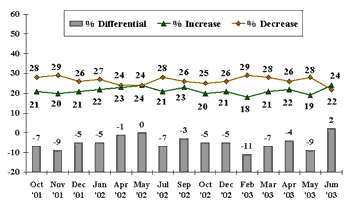GALLUP NEWS SERVICE
A month ago, it seemed clear that the much-anticipated post-war economic rally had already dissipated. Since then, consumer confidence has improved, investor optimism has surged, and the equity markets have soared. Congress has passed tax cuts that will put more money in people's hands. And now the Fed has acted to keep the momentum going by not only cutting interest rates another quarter of a percent, but also by assuring the markets that it sees inflation remaining low for the foreseeable future.
Of course, the big unknown at this point is consumer spending intentions. Will consumers respond to these strong economic stimuli by increasing spending and providing the nation's businesses with some much-needed top line revenue growth? Or, will consumer fears of the current "jobs recession" lead them to simply save more while spending and borrowing less? Gallup's consumer spending intentions data suggest that consumers may well respond by spending more. In fact, consumers could actually go on a spending spree later this summer -- just in time for "back to school."
More Consumers Plan to Spend More
In Gallup's June 12-15, 2003, poll, more consumers (24%) say they plan to spend more over the next six months than say they plan to spend less (22%). This positive differential of two percentage points (24% increase minus 22% decrease) represents a complete turnaround from May when more consumers (28%) said they planned to decrease their spending than said they planned to increase it (19%). This also means that consumer spending intentions are now at their most positive level since Gallup began tracking consumer spending intentions in this way during October 2001 -- following the Sept. 11 terrorist attacks.
The Gallup consumer intentions spending differential was negative following the terrorist attacks, but improved steadily during the first half of 2002. The negative differential disappeared in May 2002 with 24% of consumers saying they planned to spend more and an equal percentage saying they planned to spend less. During the second half of last year, however, this improved outlook for consumer spending dissipated and got even worse in early 2003. In February 2003, there was a differential of -11 and the differential in March was -7. Gallup's consumer intentions spending differential remained negative until this month.
| Overall Spending Intentions |
 |
Potential Spending Spree?
These much-improved consumer spending intentions are fully consistent with the improvement taking place in consumer sentiment. Currently, more consumers are saying economic conditions are getting better (45%) than say they are getting worse (43%). This is the first time this has happened since June 2002, when these percentages were very similar to the present numbers.
Similarly, the latest Gallup Poll shows an improvement in the way the public rates current economic conditions. In early June, just about as many consumers rate current economic conditions as "good" or "excellent" (26%) as say they are "poor" (25%) -- a differential of one percentage point (26% minus 25%). This is a substantial improvement over the way consumers rated the economy in mid-May, when the differential was -10 percentage points, and in early May, when the differential was -6 percentage points.
While the Fed's halfway measure -- lowering interest rates 25 basis points instead of 50 basis points -- reflects its assessment that "the upside and downside risks to the attainment of sustainable growth over the next few quarters are roughly equal," Gallup's mid-June polling provides reason for potentially greater optimism. The sharp turnaround in consumer perceptions and spending intentions suggests that there is a currently a great deal of positive momentum in the public's expectations for the economy's future. Add in the distribution of tax refund checks next month with the continuation of historically low interest rates, and the possibility exists that consumers could go on a "back-to-school" spending spree later this summer.
Survey Methods
Results are based on telephone interviews with 1,006 national adults, aged 18 and older, conducted June 12-15, 2003. For results based on these total samples, one can say with 95% confidence that the margin of sampling error is ±3 percentage points.

